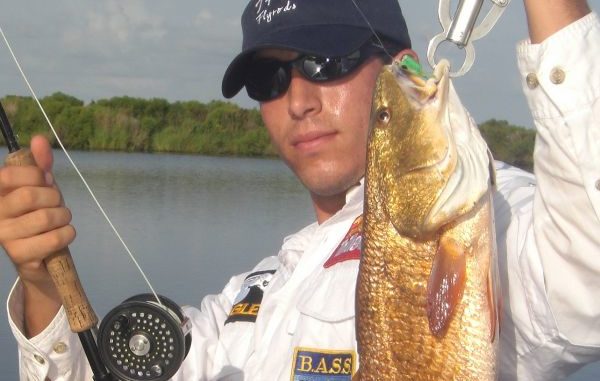
Bonding with family and friends in the marsh
Sometimes fishing is more than catching fish. It’s about spending time with others.
Then again, it’s a whole lot more fun when everyone does hook up a few times.
Take Memorial Day of 2005.
Steve Lee, Mike LaFleur, Joe Kahler and I all had the day off. We decided to make a trip to an area west of Lake Laurier, on the north side of Highway 1 between Fourchon and Grand Isle.
I’d fished this area since the late ’80s. For many years, this labyrinth of bayous, ponds and trenaisses was a redfish wonderland.
Twenty to 30 fish on the fly was a norm for a half day of fishing.
By the time we made this trip, most of the area had eroded into dozens of islands. Some were still large enough to hold two or three grassy ponds in their interiors.
Still a great environment for the poisson rouge.
At first light, we loaded our 8-weight rods into kayaks and paddled north. It didn’t take long for Mike to get into fish. As he sneaked past the edge of one island, he found several tails waving to him.
Mike fishes one fly — his “LaFleur’s Charlie.” As he often says, “It’s all you need.
It’s a variation of the classic Pink Charlie, but with a craft fur wing instead of kip tail and an estaz body instead of clear ribbing.
He made a cast into the pod and the hookup was immediate. It wasn’t a big red, but sometimes it’s the ones in that 24-inch size that put up the most fight.
This one ran like it was shot from a cannon, giving Mike a nice “Cajun sleigh ride.”
I was near Joe, stalking a bunch of black drum feeding on a flat. Black drum are difficult to take on fly because they’re so finicky. For example, they didn’t want any of the match-the-hatch patterns Joe had to offer.
But when I tied on a Coma Spoon, two of them ate.
Why do drum like a spoon fly? Along with Easter Island, the pyramids and “Who was Casper the Ghost before he died?” it’s one of the great mysteries of the world.
We each found a pond to ourselves. Steve hooked up and landed a red that pushed 10 pounds on his Boga-Grip. Mike fished a deep tidal cut and picked up several keeper trout — again on his famous fly.
I managed to catch a few reds on my own creation, the Coma Spoon.
Tied onto a fluorocarbon leader, the fly seemed suspended in the clear water filtered by the dense grass.
We met back at the launch area around noon. After loading up, we headed for a lunch spot, where we exchanged stories and shared photos.
Later that summer, Hurricane Katrina hit, followed by Hurricane Rita. Much of the marsh our group had fished disappeared.
Today, West Laurier is nearly all shallow, open water — a ghost of the world-class fishery of its former manifestation.
Another memorable Memorial Day happened two years ago. Tiger Jake and I did some father-son bonding at another area near Fourchon, fishing out of our two-man canoe.
For me, it was a rare opportunity to fish with my younger son. After four years in the Air Force, he started college at LSU, enlisted in the Air National Guard, and joined the LSU Kayak Fishing Team.
Between his obligations and studies, he seldom had a weekend for fishing with Dad.
When I picked him up, I thought I was spotting Kevin VanDam, based on all the patches on his shirt. Patches on a shirt is blasphemy in fly fishing.
While I loaded up the canoe, Jake tied on a Pete’s Perch Float Popper in green/white on the end of his 8-foot leader.
This compact popper, originated by Pete Cooper Jr., is made from a Styrofoam perch float cut in half (just as a VOSI is made). The half float is slit lengthwise, glued to a threaded hook, and painted with eyes and back color. It’s then coated with 2-ton epoxy to protect the paint.
We spotted several reds that morning. Jake would tease each one with the popper until the fish got ticked off and ate. There is nothing quite like seeing a red submarine on a popper and suck the fly in.
One thing Jake does really well — other than teasing fish — is fight them once hooked. He works the tip of the fly rod near the water, at a low angle to allow the reel’s drag to be utilized. He constantly works to turn the head of the fish, preventing it from gaining leverage.
According to the late Billy Pate, a legendary big-game fly angler, this technique can cut the fight time in half. That means better recovery for the fish once it’s released.
This coming holiday, make future memories with your fishing friends. And please be safe.


